The OnePlus 3T Review
by Brandon Chester on November 28, 2016 10:30 AM EST- Posted in
- Smartphones
- OnePlus
- OnePlus 3T
System Performance
One of the key internal changes that the OnePlus 3T brings to the table is a move from Snapdragon 820 to 821. At a high level, Snapdragon 821 is very similar to 820, and in the case of the OnePlus 3T it's really differentiated by its higher peak frequencies for the CPU and the GPU. Both have four of Qualcomm's Kryo cores in a 2 + 2 cluster configuration, and both use Qualcomm's Adreno 530 GPU. In the OnePlus 3 the performance cluster on the CPU had a peak frequency of 2.15GHz, which is brought up to 2.35GHz on the OnePlus 3T. On paper, this gives a performance improvement of roughly 10%, which is also what Qualcomm states in their marketing materials.
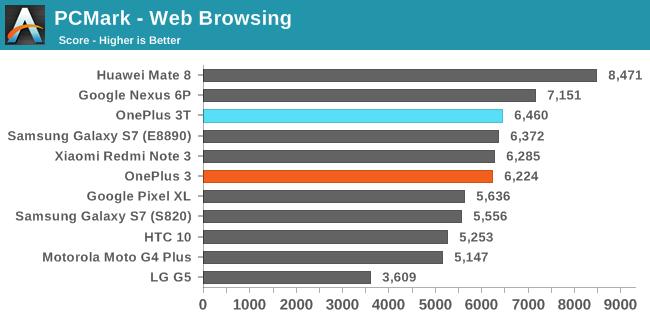
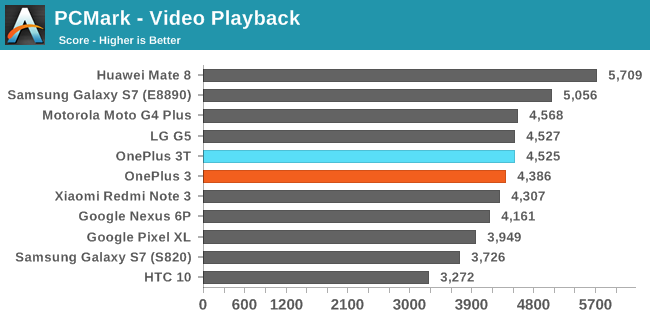
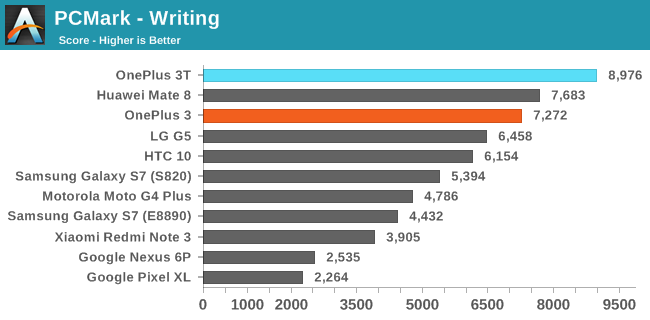


PCMark is a test that the OnePlus 3 performed exceptionally well in. This was due not only to the use of Snapdragon 820, but to software optimizations that OnePlus had made to the OS and the Android Runtime as well. The OnePlus 3T continues this trend, and provides performance improvements across the board. The writing and photo editing tests are the most interesting of the group, as these are tests where software optimizations helped the OnePlus 3 to pull ahead of other competing devices, and the OnePlus 3T pulls ahead even further. It bests the Huawei Mate 8 in the writing test to become the fastest device on record, and the photo editing test improves over the OnePlus 3 which was still the fastest device in the test up until now.
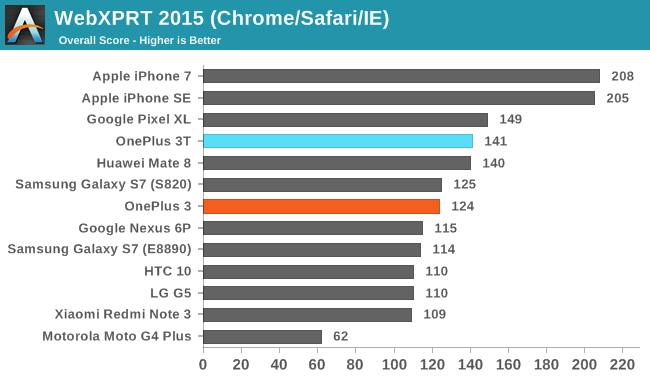
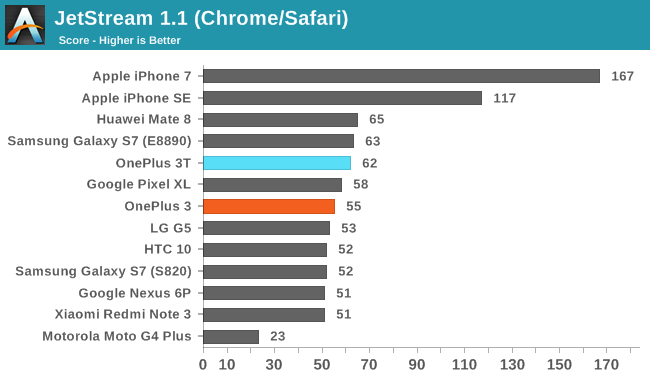
The OnePlus 3T's JavaScript performance benefits from improvements that Google has made in Chrome 54, as well as the increase in peak CPU frequency compared to the OnePlus 3. In the interest of having a fair comparison, I've updated the OnePlus 3's results using the latest version of Chrome so it can also take advantage of optimizations that have been made.
Kraken and WebXPRT 2015 both demonstrate the OnePlus 3T's improved JavaScript performance. The gap is actually a bit larger than one might expect from a 10% increase in CPU frequency, and this could simply be the result of other changes made to the operating system in the newer version of OxygenOS, or changes to the DVFS settings that have been made alongside the change in SoC. Jetstream shows a smaller improvement, but it's in line with what you'd expect to see from the CPU bump.
Ultimately, Snapdragon 821 doesn't come with any mind-blowing performance improvements for CPU-bound applications, but the update does keep OnePlus on par with the competition, and allows them to take advantage of improvements in efficiency and errata fixes in addition to a modest performance uplift. Certain parts of the PCMark test also indicate that the 3T comes with additional improvements at the software level, which will hopefully make their way to the OnePlus 3 with the next major update to OxygenOS, but for now are something you only get on the OnePlus 3T.


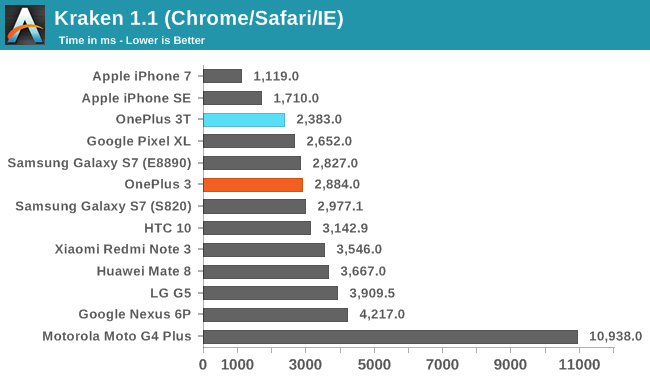








104 Comments
View All Comments
arayoflight - Tuesday, November 29, 2016 - link
Do you have any proof it's using UFS 2.1. Looks like regular UFS 2.0 with F2FS filesystem to me.To confirm that, I installed androbench on my Oneplus 3, set the parameters to what Anandtech uses(256 KB read for seq, 4KB for random and 1 I/O thread).
Since my Oneplus 3 is running on F2FS too(OxygenOS 3.5.6 has it by default)
Here are the results I got:
Random Read: 21.35 MB/s
Random Write: 25.21 MB/s
Seq read: 264.23 MB/s
Seq write: 140.4 MB/s
These are almost exactly equal to the results from the 3T in the review. Hence, I think they are not using UFS 2.1 on the 3T.
Meteor2 - Tuesday, November 29, 2016 - link
Indeed, I see no suggestion that UFS 2.1 is being used in the 3T.andrewaggb - Monday, November 28, 2016 - link
My top 3 for a smartphone are screen, cameras, battery life. This upgrade improves on 2 of them.mgl888 - Monday, November 28, 2016 - link
I wish the review tested the new front facing camera.boeush - Monday, November 28, 2016 - link
I agree with Brandon on the camera aspect: it would have been valuable to upgrade the rear camera; the front camera upgrade isn't really worth the money if the older model was already good-enough.Mr Perfect - Monday, November 28, 2016 - link
OnePlus gets a lot of love these days. I'd consider one, but the OS updating is a little hazy. What are the community builds people talk about? Does OnePlus make a release version, then open source it to the community to maintain? Are they talking about Nougat in any way?I was hoping they'd become the new Nexus, but it looks like they're not there yet.
JoeyJoJo123 - Monday, November 28, 2016 - link
CyanogenMod supports OnePlus phones, and I'm sure OnePlus 3T will come very soon.If it's any reconciliation, my Nexus 4 is on CyanogenMod 13 (Android 6.0 - Marshmallow) even though Google chose to end support for the Nexus 4 before Marshmallow even came to the Nexus 4.
JoeyJoJo123 - Monday, November 28, 2016 - link
Additionally:https://en.wikipedia.org/wiki/CyanogenMod#Cyanogen...
"The first experimental build of Cyanogenmod 14.1 based on Android 7.1 was released for Oneplus 3 device..."
So even though OnePlus themselves haven't released a Nougat equivalent of OxygenOS, yet, CyanogenMod's been on the ball, and even sourced their newest OS to the OnePlus 3 first.
There's really 3 major brands of phones that Cyanogenmod tends to support well today: Motorola, Samsung, and LG. Of those, only Motorola sometimes comes with an unlocked bootloader and root access. OnePlus phones come with that standard, as is usual with Nexus phones.
In many ways, OnePlus supplanted the Nexus line. Alternatively there's a few Motorola phones that come with unlocked bootloaders (and are marketed as Developer editions), etc.
Mr Perfect - Monday, November 28, 2016 - link
Good info, thanks. I was hoping OnePlus would be an all-in-one hardware and software solution like Nexus was, but throwing CyanogenMod on solid hardware is the next best thing.UtilityMax - Wednesday, November 30, 2016 - link
I don't get the obsession about frequent updates. To my humble eye, Lollipop, Marshmallow, and Nougat look almost the same. Nougat barely adds anything new, and Marshmallow was viewed as a bug-fix release to Lollipop. The Nexus device users were the first one to receive Nougat, but the sad reality is that Google is using them as beta testers.Regarding, Oneplus updates, based on my experience with Oneplus One, I think Oneplus updates were pretty honest. The device came out with KitKat, then got updated to Lollipop (after a lengthy delay), and then to Marshmallow. Not bad for a device that shipped with KitKat. My Samsung tablet got the same treatment, but a lot slower than Oneplus One.